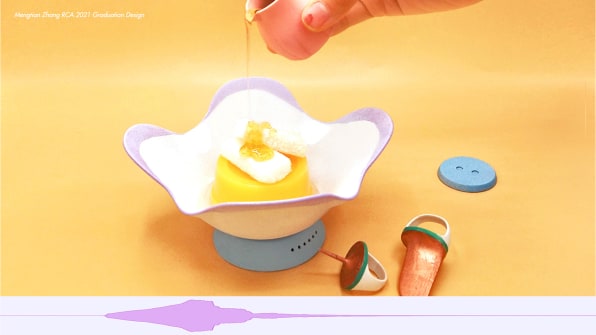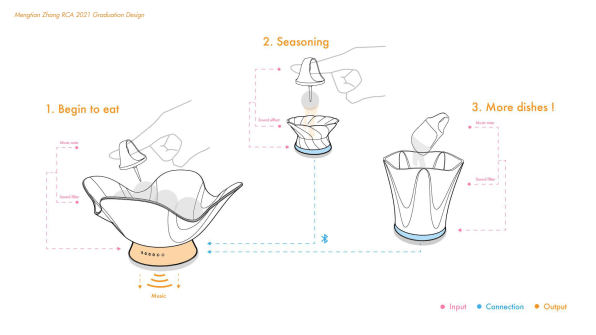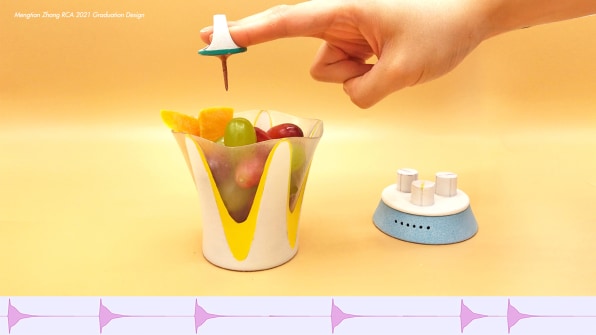Grapes are a fun food to eat. The tiny spheres seem so smooth and simple—little flavorless orbs. Then they burst between your teeth with sweet, juicy goop. But what if, each time you touched a grape, it also made a little “boop” sound? And as you chewed, you heard bubbles popping in your ears?
That’s the delightful premise behind Sonic Seasoning, the graduation project of RCA student Mengtian Zhang. Inspired by ASMR—the tingling sensation people can get from certain sounds (and most recently, a slew of therapeutic YouTube videos)—it’s a plate and cutlery set that adds all sorts of sounds to the foods you eat, with the hopes of enhancing their flavor.

The project was inspired by Zhang’s own COVID-19 lockdown experience, in which she turned to ASMR cooking videos to calm herself. As for many other people, hearing the exaggerated sounds of someone else cooking or eating their meal can create a sense of satisfaction and social connection, even through a simple YouTube window.
“I can feel the texture and flavor of food such as crunchiness and freshness behind the phone screen,” says Zhang. “So I was thinking, Could we use sound and visual effects to enhance our taste and build expectations before eating?”
What Zhang designed in response is the set of plates and cutlery you see here. Each is connected to various sensors to measure the food it is touching. The sensors send electrical signals to a processor, which plays the impulses like notes on a synthesizer. All of these connected pieces of tableware can actually create a complete circuit as a bite of food enters your mouth, so the system knows when you actually take a bite to play accompanying sound.

Zhang experimented with different approaches between her sketched concept and physical prototypes. She imagined that an infrared sensor could scan each food, measuring its chemical compounds to create a matching score. And she imagined wearable electronics that could sense chewing. But in her actual built prototype, things work a bit differently. The hand tools, like a scoop or toothpick-like poker, measure the pressure and duration of your force—responding with a certain pitch or chord. Meanwhile, each bowl or plate acts as a sound filter, tweaking the resonance of each hand tool, kind of like the body of a guitar or cello. A finger bowl called a “seasoning device” lets you dip in a piece of food, playing extra sounds like crunches or bubbles. And a DJ station—an actual electronic-looking component with various knobs—lets you tune the sounds to your liking as you eat.
When Zhang began working on the project, she thought it would simply be a more playful way to eat. But through her research, she is convinced there’s something more here. While you don’t often think of sound as a critical component of flavor, research has shown that it is. One study found that playing certain pitches can actually increase the umami or bitter flavors within food. Another discovered that people perceived stale potato chips as crispy if they heard a crunch with their bite. “I think the whole eating experience should be full of fun at first, and then people will focus on the sense of taste changing subtly with sound,” says Zhang.

In the future, Zhang would like to collaborate with a restaurant or science museum on a full dinner served on her tableware. She also imagines that, with enough tuning, a system like hers could bring more joy and flavor to food that might be lower in sugar or fat. But even without leveraging the hard science of flavor modification, her playful eating tools would make it fun to eat just about anything at all. As Zhang says: “I hope the funny part of the work could reduce the pain of having a diet.”







